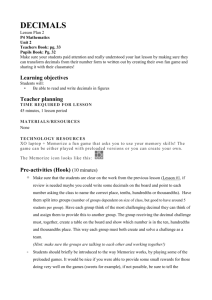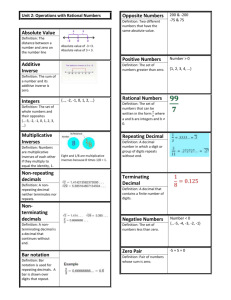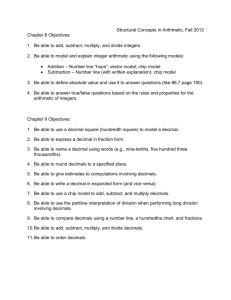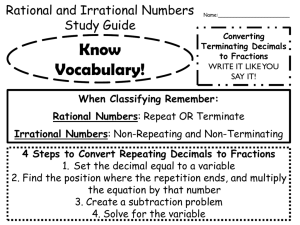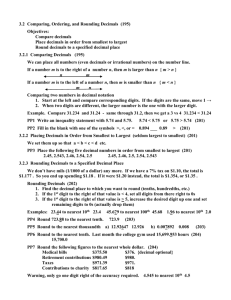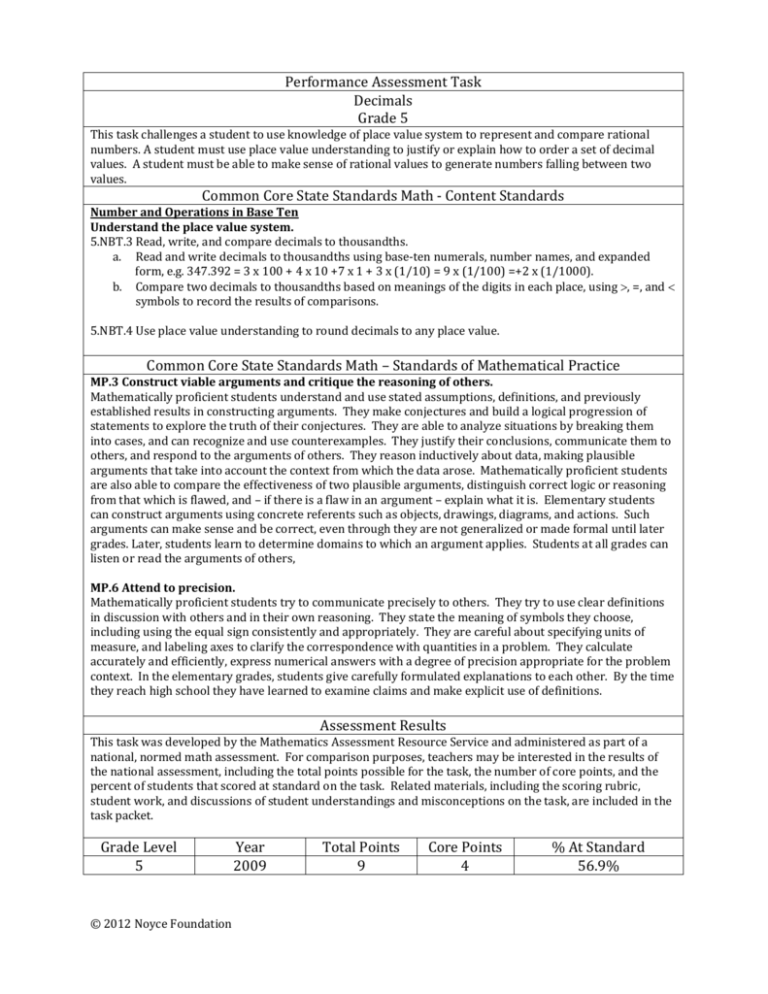
Performance Assessment Task
Decimals
Grade 5
This task challenges a student to use knowledge of place value system to represent and compare rational
numbers. A student must use place value understanding to justify or explain how to order a set of decimal
values. A student must be able to make sense of rational values to generate numbers falling between two
values.
Common Core State Standards Math - Content Standards
Number and Operations in Base Ten
Understand the place value system.
5.NBT.3 Read, write, and compare decimals to thousandths.
a. Read and write decimals to thousandths using base-ten numerals, number names, and expanded
form, e.g. 347.392 = 3 x 100 + 4 x 10 +7 x 1 + 3 x (1/10) = 9 x (1/100) =+2 x (1/1000).
b. Compare two decimals to thousandths based on meanings of the digits in each place, using >, =, and <
symbols to record the results of comparisons.
5.NBT.4 Use place value understanding to round decimals to any place value.
Common Core State Standards Math – Standards of Mathematical Practice
MP.3 Construct viable arguments and critique the reasoning of others.
Mathematically proficient students understand and use stated assumptions, definitions, and previously
established results in constructing arguments. They make conjectures and build a logical progression of
statements to explore the truth of their conjectures. They are able to analyze situations by breaking them
into cases, and can recognize and use counterexamples. They justify their conclusions, communicate them to
others, and respond to the arguments of others. They reason inductively about data, making plausible
arguments that take into account the context from which the data arose. Mathematically proficient students
are also able to compare the effectiveness of two plausible arguments, distinguish correct logic or reasoning
from that which is flawed, and – if there is a flaw in an argument – explain what it is. Elementary students
can construct arguments using concrete referents such as objects, drawings, diagrams, and actions. Such
arguments can make sense and be correct, even through they are not generalized or made formal until later
grades. Later, students learn to determine domains to which an argument applies. Students at all grades can
listen or read the arguments of others,
MP.6 Attend to precision.
Mathematically proficient students try to communicate precisely to others. They try to use clear definitions
in discussion with others and in their own reasoning. They state the meaning of symbols they choose,
including using the equal sign consistently and appropriately. They are careful about specifying units of
measure, and labeling axes to clarify the correspondence with quantities in a problem. They calculate
accurately and efficiently, express numerical answers with a degree of precision appropriate for the problem
context. In the elementary grades, students give carefully formulated explanations to each other. By the time
they reach high school they have learned to examine claims and make explicit use of definitions.
Assessment Results
This task was developed by the Mathematics Assessment Resource Service and administered as part of a
national, normed math assessment. For comparison purposes, teachers may be interested in the results of
the national assessment, including the total points possible for the task, the number of core points, and the
percent of students that scored at standard on the task. Related materials, including the scoring rubric,
student work, and discussions of student understandings and misconceptions on the task, are included in the
task packet.
Grade Level
5
© 2012 Noyce Foundation
Year
2009
Total Points
9
Core Points
4
% At Standard
56.9%
Decimals
This problem gives you the chance to:
• show understanding of decimal numbers
1. Write each of this set of numbers in the correct box.
The box on the left is for numbers smaller than 5.5.
The box on the right is for numbers bigger than 5.5.
5.7
5.35
5.025
5.9
5.24
5.473
The first one has been done for you.
Numbers smaller than 5.5
Numbers bigger than 5.5
5.7
2. Which number is nearest to 5.5?
Explain how you figured this out.
_______________________________
___________________________________________________________________
___________________________________________________________________
3. Write down a number of your own that is bigger than 5.24 and smaller than 5.35.
____________
4. Write the numbers in order from smallest to largest.
______________________________________________________________________________
Explain how you decided which was the smallest number.
_____________________________________________________________________________
_____________________________________________________________________________9
Grade Five
Copyright © 2009 by Mathematics Assessment
Resource Service. All rights reserved.
Decimals
85
Decimals
Rubric
The core elements of performance required by this task are:
• show understanding of decimal numbers
Based on these, credit for specific aspects of performance should be assigned as follows
1.
points
section
points
Gives correct answers:
3
In the left hand box: 5.35 5.025 5.24 5.473
In the right hand box: (5.7), 5.9
Partial credit
Lose one point for each number incorrectly placed
2.
(2)
(1)
Gives correct answer: 5.473
3
1
Gives a correct explanation such as:
It rounds to 5.5 and no other number does.
2
1
3.
Gives correct answer: any number larger than 5.24 and less than 5.35
1
4.
Gives correct answer: 5.025
2
5.24
5.35
5.473
5.7
5.9
Partial credit
One error or
First and last correct.
1
(1)
Gives a correct explanation such as:
I looked at the first number after the decimal point and choose zero because
it was smallest.
Total Points
Grade Five
Copyright © 2009 by Mathematics Assessment
Resource Service. All rights reserved.
1
3
9
86
Decimals
Work the task and look at the rubric. What are the big mathematical ideas being assessed in this
task?______________________________________________________________
Students seemed to have difficulty comparing numbers with different numbers of digits. This is
easiest to see by looking at how students ordered numbers in part 4. How many of your students
were able to:
• Order all of the numbers correctly?___________
• Ordered most numbers correctly (1 or 2 numbers misplaced)?___________
• Order all the numbers with tenth, then the numbers with hundredths, then the numbers with
thousandths?
• Ordered the wrong set of numbers or made up their own numbers?_________
Why do you think students have difficulty with this idea? What are some of their underlying beliefs
about digits and size of numbers? What kinds of activities will help them confront those fallacies
explicitly?
Now look at how students compare numbers in part 2. How many of your students put:
5.473
5.7
5.35
5.025
Other
List some of the rationales students made for their comparison.
How many students used the idea of comparison subtraction?_________
Did students attempt comparison of more than one choice to determine the optimal
solution?__________
How do we help students to develop the habit of mind of comparing more than one possibility before
making a decision?
Now look at explanations in part 4, how did you determine the smallest number. List some
examples that showed a good understanding of place value.
What were some of the explanations that showed problems with understanding place value?
Grade Five
Copyright © 2009 by Noyce Foundation
All rights reserved.
87
Looking at Student Work on Decimals
Student A is able to meet all the demands of the task. Notice that the student understands, but has
difficulty with the language, that the tenths need to be compared before hundredths. What do you
think the student means by there is nothing in the tenths place? What do you want students to
understand about zero in the tenths place? How often do students get opportunities to use language
around place value? How does conversation and developing academic vocabulary expand the ways
students think mathematically?
Student A
Grade Five
Copyright © 2009 by Noyce Foundation
All rights reserved.
88
Students really struggled with the thinking needed to explain why a number is smallest.
See the work of Student B.
Student B
Student C is starting to make comparisons between numbers. In part 2 the student compares two
options before making a choice. In part 4 the student chooses between two choices with digits in the
thousandths, but doesn’t seem to be able to articulate how to compare numbers with different
numbers of digits. This is interesting because the student was able to order all the numbers. Again,
how do we help students develop the ability to think with academic language and use it to make
sense of our choices?
Student C
Grade Five
Copyright © 2009 by Noyce Foundation
All rights reserved.
89
Student D compares numbers in the tenths when making a choice in part 2. In part 4 the student
understands which number is smaller and can give additional information about the number by
writing it as a fraction. But, the student does not have the idea of making a comparison between the
whole set of numbers.
Student D
Grade Five
Copyright © 2009 by Noyce Foundation
All rights reserved.
90
Student E is able to correctly choose the number closest to 5.5, but has no supporting logic. Its
closest because it closest. In part 4 the student orders the wrong set of numbers, but the logic is still
the same. It is smallest because its smallest. How do we help students understand the logic of
making a convincing argument?
Student E
Grade Five
Copyright © 2009 by Noyce Foundation
All rights reserved.
91
Student F has some vocabulary to indicate distance in part 2, but doesn’t quantify the distance. The
student only considers the one possibility. In part 4 the student makes up her own set of numbers to
order. Notice the student doesn’t understand the two of the choices are equal.
Student E
Student F has a more limited flexibility in working with place value. While the student can realize
that the 5.025 is smaller than 5.7, the student doesn’t recognize that 5.473 is also smaller than 5.7.
The language in part 2 does not indicate measuring the distance between numbers and 5.5 to make
the comparison. In part 4 the student has chosen only some of the numbers to order. What
experiences do you think this student might need?
Grade Five
Copyright © 2009 by Noyce Foundation
All rights reserved.
92
Student F
Grade Five
Copyright © 2009 by Noyce Foundation
All rights reserved.
93
Look at the work of Student G. What strategy do you think the student uses to order the numbers?
What is the misconception?
Student G
Grade Five
Copyright © 2009 by Noyce Foundation
All rights reserved.
94
5th Grade
Student Task
Core Idea 2
Number
Properties
Task 5
Decimals
Show understanding of decimal numbers.
Understand numbers, ways of representing numbers, relationships
among numbers, and number systems.
• Recognize and generate equivalent forms of commonly used
fractions and decimals.
• Understand the place-value structure of the base-ten number
system including being able to represent and compare rational
numbers.
Mathematics of the task:
• Comparing decimal numbers with different numbers of digits
• Understanding than comparison involves looking at all the options
• Understanding zero as a place value
• Making a mathematical justification
• Being able to use place value language in context to make explanations and convincing
arguments
Based on teacher observations, this is what fifth graders knew and were able to do:
• Order decimals with the same number of digits and find numbers between
• Sort some of the numbers in relation to the 5.7
Areas of difficulty for fifth graders:
• Making a comparison after considering all the alternatives
• Using academic language in context
• Making comparison between decimals with different numbers of digits
Grade Five
Copyright © 2009 by Noyce Foundation
All rights reserved.
95
The maximum score available for this task is 9 points.
The minimum score needed for a level 3 response, meeting standards, is 4 points.
Most students, 90%, could find a number between two values with the same number of digits. More
than half the students, 57%, could also sort the numbers into the two boxes (greater than 5.5 and
smaller than 5.5). Some students, about 38%, could also order the decimals and choose the smallest
one. About 23% were able to meet all the demands of the task including comparing the numbers and
choosing the one closest to 5.5. Almost 10% of the students scored no points on this task. All of the
students in the sample with this score attempted the task.
Grade Five
Copyright © 2009 by Noyce Foundation
All rights reserved.
96
Decimals
Points
Understandings
All the students in the sample
0
1
4
7
9
with this score attempted the
task.
Students could find a number
between two decimal values in
the hundredths.
Misunderstandings
Students had difficulty finding a number
between 5.24 and 5.35.
Students had difficulty sorting the numbers
into more than 5.5 and less than 5.5. 15%
put all the numbers in the box for greater
than 5.5. 8% put all the numbers in the box
for less than 5.5. 18% misplaced 5.473.
12% misplaced 5.24.
Students could sort the values
Students had difficult ordering the numbers
between less than 5.5 and
from smallest to largest and explaining how
greater than 5.5 and find values to identify the smallest number. 37%
between 5.24 and 5.35.
ordered by number of digits (5.7, 5.9, 5.24,
5.35, 5.025, 5.473.
Students could sort and order all Students had difficulty finding the value
the values, identify the smallest closest to 5.5. Students often only
value, and locate values
considered one or two numbers before
between 5.24 and 5.35.
making a choice. 56% thought the closest
number was 5.7.9% thought the closest
value was 5.35.
Students understood decimal
place value and could compare
values of numbers with
different amount of digits after
the decimal point.
Grade Five
Copyright © 2009 by Noyce Foundation
All rights reserved.
97
Implications for Instruction
While students could order and compare numbers with the same number of digits after the decimal,
students struggled with ordering and comparing numbers of differing amounts of digits after the
decimal. While it is convenient for reading answers to say 5 point 24, this use of language takes the
concept of “value” out of what is heard and communicated. Although it may at first be confusing to
some students that use of mathematical language in decimals is critical for building a meaning and
sense of value.
Learning to “go around” significant numbers is an important step for beginning counters. What
comes after 58, 59 … or 98, 99, … When students are learning place value, they need to go through
some of those same counting strategies to make sense of value. Activities, such as finding what is
1/10 more than 3.6 or 4.87 or what is 3/100 less than 5.78 helps students develop this sense of order.
Students should have frequent opportunities to locate values on a number line to help them recognize
relative values. This helps them see the difference between numbers like 5.473 and 5.7 without
learning or remembering procedures like adding zeroes to make all the numbers the same size.
Students need a variety of activities, both verbal and written, to help them make sense of numbers
with a different amount of digits after the decimal.
Ideas for Action Research
Plan some lessons or warm ups to help students become more fluent with place value meaning. Start
with some tasks of adding a constant amount (similar to skip counting at earlier grade levels). For
example, give students a short series of problems, such as:
1. 0.2, 0.4, 0.6, _______,_______,________,________ (add on 0.2 each time)
2. 0. 25, _______,_________,_______ (add 0.25 each time)
3. 0. 05, _____, ______,______(add 0.05 each time)
Don’t worry about mistakes at this time. The purpose of the activity is to let students self-correct and
confront their misunderstandings. When the students have finished give them number lines where
they can mark the growth on the number and see their errors. Then have them reconfirm the answers
using a calculator.
Grade Five
Copyright © 2009 by Noyce Foundation
All rights reserved.
98
Example taken from Mathematics Navigator, Deimals and Powers of Ten published by America’s
Choice.
Another simple lesson is to make a list of four or five decimal numbers that students might have
difficulty putting in order, such as the number set from the task. Ask students to predict the order of
the numbers from least to greatest. After everyone has made their predictions, put a large number
line on the white board at the front of the class. Now use this as to have students discuss the precise
locations of the numbers. By making a blank number line, the endpoints can be changed to make
new problems.
Example taken from Teaching Student-Centered Mathematics, Grades 5-8 by John Van de Walle.
A final activity might be to look at the concept, “close to”. Start with a four-digit decimal on the
board, such as 4. 1736. To get students thinking, first ask them to consider if the number is closer to
4 or 5. Then slowly think about narrowing in on the place values. Is it closer to 4.1 or 4.2? In
conjunction with this type of warm up, it might also be good to ask them to compare. How close is
it to 4.2? to 4.15? This helps students to really locate the number relative to a variety of landmarks.
Grade Five
Copyright © 2009 by Noyce Foundation
All rights reserved.
99




